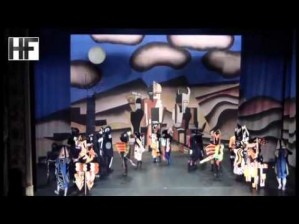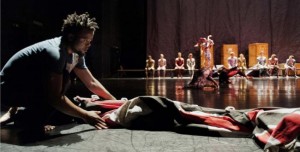
Faustin Linyekula & CCN-Ballet de Lorraine
La Création du monde 1923 – 2012
Recreation of the choreography of 1923: Millicent Hodson & Kenneth Archer
 see an excerpt here at youtube
see an excerpt here at youtube
Body politics is of great concern these days, and here in the West we are so often subject to it through subtle and habitual ways, that we may barely notice. But what if you had to experience these physically on various levels? Levels that include where and with whom one can live, the conditions of work, and not to forget how one is looked at. All this defines the physicality of politics for Faustin Linyekula. Not only has he been through these experiences, he decided to make the body his site of work. By claiming “my only true country is my body,†he expresses these very insights that define every inch of the body as an experience of the political, and politics as overtly physical. (quoted from David Van Reybrouck “My only true country is my body.” )
So what then when even your body becomes occupied? An occupation by the gaze as the projections of fantasies, which neglects the reality these evolve from and in turn effect?
“We have learned to look at ourselves with the gaze of the West,†says Linyekula.
At least in the European West, though, there seems to be a difficulty to fully understand why he suggests that the beautiful and highly artistic imaginary of the piece ‘La Creation du Monde’ by B.Cendars, D.Milhaud, F.Léger, and J.Börlin, cannot be staged today without a framing context.
The piece itself has been created in 1923 as “ballet nègreâ€, and as the program of the tanzkongress states: “a symbolic creation story that was meant to enable a fresh artistic start after the First World War. The model was “Africa†– but a naively paradisiacal image of it, which stood in stark contrast to the economic exploitation and political oppression of the colonies.†(quoted from tanzkongress.de)
The recent reconstruction by Millicent Hodson and Kenneth Archer of ‘La Creation du Monde’ is embedded as a whole into the choreography of Linyekula, as an attempt to question the themes of appropriation and foreignness. Staged as an encounter between the past and present, this work presents different views of a “common†history that questions the image many still seem to hold on to. As Linyekula notes, it is a very naïve, pretty and exotic image that was given of Africa, but though we are almost one hundred years onwards, not much really has changed. “After the tragedy that has been World War I in Europe, some intellectuals in Paris, in their quest for a new spring, turned toward Africa and refused to see the real Africa, or what was going in Africa then, they only chose to see the image they were projecting themselves on Africa.†(quoted from an interview with F.Linyekula)
The work of scholar Edward Said’s The work of Edward Said analyses that it is the imposed image onto the other that operates, as representations usually do, informed by purpose within a specific historical, intellectual, and even economic setting. Meanwhile, it has been noted that the effects of colonialism show up in the symptoms that surround, often dramatically, the slow evolvement of post-colonialism. In the current state of former or still colonized areas of the world, there is still a quite some tendency to not acknowledge a phantasmic involvement of the West, the own not looking, the own seeing anything but oneself’s involvement. Fascination lets you fantasize about the other.
Or as K.P.Köpping in his lecture on the theme of the “imagined other†defined, it is the phantasm that is used to liberate one’s own body from its trauma, (which in his case meant the 1st WW) through the fantasy of the ‘other’ and by this mutilates the body of the ‘other’, especially when perceived to be the weaker one. In this point his comparison of the ritual of the Hauka group in West Africa (they were mainly from Niger), that is initiated to overcome their traumatic experiences with oppressive forces (as documented in “Les Maitres Rouche†by J. Rouche, 1955) with the imagination that is posited upon the African body in ‘La Creation du Monde’ is a very different form of mutilation towards an imagined body.
But it is this very point where the work of Faustin Liyekula wants to put its finger into the wound: “Because the tragedy of it all is that we continue to see ourselves through the eyes of Europe. … I’m here and what is it that I can do from wherever I am, whether an artist or a doctor.†(F.Linyekula)
This is the wound imposed on Africa, and consequently Europe / West needs to look at this and accept that they wanted to neglect another pain – one that is not belonging to the ‘other’ – by locking away their own bodies. It is the very point that the argument of Linyekula takes up – why did they (in this case a group of European intellectuals, who obviously had access to books by major critics that included Albert Londres, Félicien Challaye, and Paul Monet ) fantasize on the body of the ‘other’ that oppresses an emphatic view on the real events that included the violent mutilation of bodies through the colonial powers. It is as if Europe (to use this generalization once) did not want to acknowledge the phantom pain of its own lost limbs during its wars, as he reminds us that B. Cendrars, the author of the piece had lost his right arm in 1915.
Faustin Linyekula posts provacative, urgent and painful questions, but not only for the African audience by asking it to search for its own view. He also demands the Western audience to research the reason for their own traumatic neglect, for the phantom limb pain, that they forwarded onwards onto the ‘other’.
Said in his seminal work ‘Orientalism’ quotes from Nietzsche (which I transpose here onto what generally is regarded as ‘common’ knowledge) as a reminder that the truth of language, is but
“…a mobile army of metaphors, metonyms, and anthropomorphisms – in short, a sum of human relations, which have been enhanced, transposed, and embellished poetically and rhetorically, and which after long use seem firm, canonical, and obligatory to a people: truths are illusions about which one has forgotten that this is what they are.†(Edward Said, Orientalism, 1978, p.203)
In framing the naïve cubist-modernist dance piece with his own choreography and having it all performed in a staging of an almost heterogeneous group of dancers that barely shows any diversity in other skin tones other than white or fair, Linyekula displays the set of relations within which the piece has been conceived. The only African dancer, whom he integrated only three weeks before the premiere form his own group, navigates as the black identity marker.
It is the bodies of the dancers of the CCN-Ballet de Lorraine, all trained in European or Western ballet and post-modern dance styles (most likely already displaying the hybrid body, S.L. Cherakaoui spoke about, which today manages to combine the different styles which before set each other purposefully apart) which transpose the non-knowledge of African dance, even though they attempt some of the typical figures of Linyekula’s choreographic work.
But it is the singular body of Djodjo Kazadi who tells the very different story of the African (body) rather than the idealized ‘La Creation du Monde’. His movement is quite restricted to slow but enduring pelvis rotation in the beginning and later on limited to stage setting tasks until the last section, when – at least in the staging I saw – he escapes the role of the subaltern. While the dancers of the re-staging of ‘Le Creation du Monde’ remove their masks and bow for the audience, he animates the seemingly irritated crowd to applaud to the performance.
It was a stunning moment as there was a reluctance of the viewers that reminded to the awakening from a deep colorful dream. This search for orientation (and eventual classification) was interrupted and attention forced back onto the reality of the stage when D. Kazadi, now wearing the same tight all-body-suit as the dancers of CCN before, started reciting facts and setting of the piece. Reminding to F. Fanon’s ‘wretched of the earth’ he finally started to scream about the traumatic humiliation. In a reconciling act the other dancers surround him and celebrate one of their conforming group rituals which also appear in other pieces of Linyekula.
